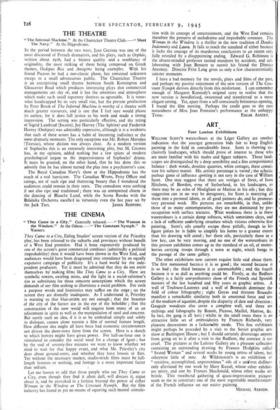ART
Four London Exhibitions
WILLIAM Scores watercolours at the Leger Gallery are another indication that the younger generation bids fair to keep English painting in the field in considerable force. Scott is showing exclusively landscapes, which should prove of interest to those who are more familiar with his nudes and figure subjects. These' landscapes are distinguished by a deep sensibility and a fine compositional balance : dark woods, desolate quarries, white cottages these constitute his subject matter. His artistic parentage is varied; the eclectic parlour game of influence spotting is not easy in the case ,of William Scott. One may suggest that there are vestiges of Steer, of Ivon Hitchens, of Bawden, even of Sutherland, in his landscapes, as there may be an echo of Modigliani or Matisse in his oils ; but this suggestion can in no way be derogatory, for Scott is marrying all these into a personal idiom, as all good painters do, and he promises. very personal work. His pictures are remarkable in that, unlike those of so many contemporaries, they are not dominated by pre-. occupation with surface textures. What weakness there is in these watercolours is a certain damp softness, which sometimes cloys, anda lack of sufficient underlying structure which vitiates otherwise fine painting. Scott's oils usually escape these pitfalls, though in his figure pieces he is liable to simplify his forms to a greater extent than his drawing will stand ; bur these oils, particularly those in a low key, can be very moving, and no one of the watercolours in this present exhibition comes up to the standard of an oil, of motorlorries carrying troops through a town at night, -which hangs in the passage of the same gallery.
The other exhibitions now current require little said about them. The first mentioned because it is so good ; the second because it is so bad ; the third because it is. unremarkable ; and the fourth because it is as dull as anything could be. Firstly, at the Redfern Gallery is a fairly comprehensive show of the French and Spanish masters of the last hundred and fifty years as graphic artists. A wall of Toulouse-Lautrecs and a wall of Bonnards dominate the field of colour lithography ; eight Goyas and thirteen Renaults 'manifest a remarkable similarity both in emotional force and use of the medium of aquatint, despite the disparity of date and direction ; Gauguin woodcuts also cover a complete wall, and there are etchings and lithographs by Renoir, Picasso, Maillol, Matisse, &c. In fact, the gang is all here 7 whilst in the, small room there is an attractive little set of embroideries by Frances Richards, very pleasant decorations in a fashionable mode. This fine exhibition might perhaps be preceded by a visit to the Soviet graphic arts show at Burlington House ; but I should certainly discourage anyone from going on to it after a,visit to the Redfern, the contrast is too cruel. The pictures at the Lefevre Gallery are a pleasant collection containing an outstanding drawing by Frances Hodgkins called "Seated Woman" and several works by young artists of talent, but otherwise little of note. At Wildenstein's is an exhibition of "sensitive, accomplished, unpretentious" oils of a uniform dullness only alleviated by one work by Mary Kessel, whose other exhibits are misty, and one by Frances Macdonald, whose other works are brittle. This moribund gathering of quasi-impressionist pictures seem to me to constitute one of the most regrettable manifestations of the French influence on our native painting.






















 Previous page
Previous page